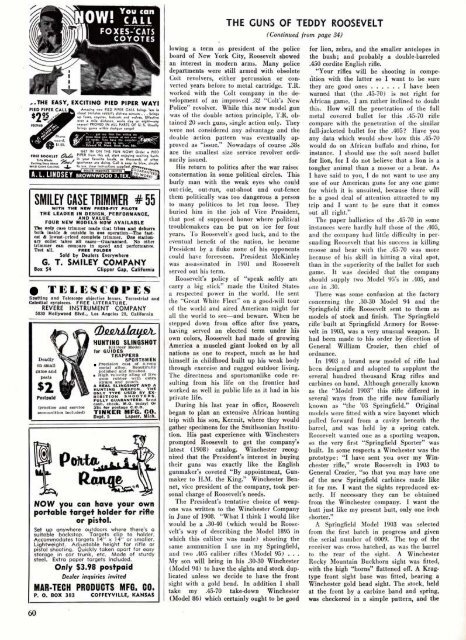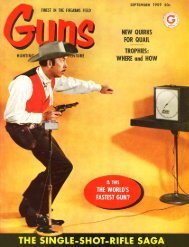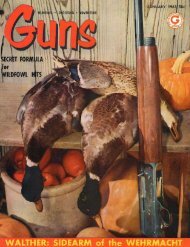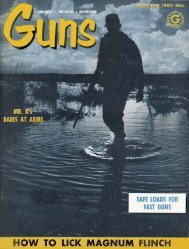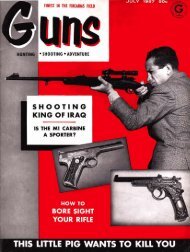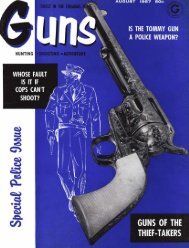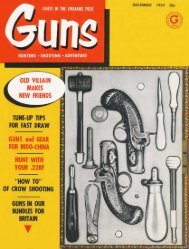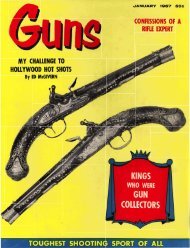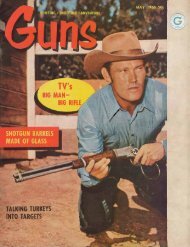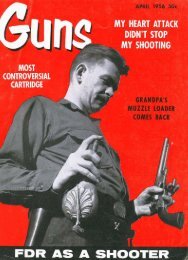You also want an ePaper? Increase the reach of your titles
YUMPU automatically turns print PDFs into web optimized ePapers that Google loves.
SMILEY CASE TRIMMER --- ~-~ # 55 - -<br />
WITH THE NEW PRESS-FIT PILOTS<br />
THE LEADER IN DESIGN, PERFORMANCE,<br />
AND VALUE.<br />
FOUR NEW MODELS NOW AVAILABLE<br />
The Only case trimmer made that trims and deburn<br />
both inside & outside in one oueratlon-The fastest<br />
& lowest-orlced complete trimmer. One statlonarv<br />
collet takes all cases-Guaranteed. No other<br />
trimmer can compare In speed and performance.<br />
T& ÈU PRK FOLDER<br />
Sold by Dealers Everywhere<br />
G. T. SMILEY COMPANY<br />
Box 54 Clipper Cap, California<br />
TELESCOPES<br />
Swttino and Telescope objective lenses. Terrestrial an<br />
Celestial eyepieces. FREE LITERATURE.<br />
REVERE INSTRUMENT COMPANY<br />
5830 Hollywood Blvd., Los Angeles 28, California<br />
(practice and service<br />
ammunition included)<br />
for GUIDES<br />
TRAPPERS<br />
SPORTSMEN<br />
Precision cast of atrang<br />
metal alloy. Beautifully<br />
polished and finished.<br />
velocity sling of live<br />
. High<br />
gum rubber with extra<br />
straps and pouch.<br />
A REAL SLINGSHOT AND A<br />
HUNTING WEAPON. THE<br />
ONLY TYPE USED BY EX-<br />
HIBITION SHOOTERS.<br />
FULLY GUARANTEED. Send<br />
yg,w;h;$ta~io6,zy or<br />
NOW you can have your own<br />
portable target holder for rifle<br />
or pistol.<br />
Set up anywhere outdoors where there's a<br />
suitable backstop. Targets clip to holder.<br />
Accommodates targets 14" x 14" or smaller.<br />
Lightweight. Adjustable height for rifle or<br />
~istol shootina. Ouicklv taken aDart for easv<br />
ztoGge in tor fiunktZetc. ~ade of sturdy<br />
steel. Extra paper targets included.<br />
Only $3.98 postpaid<br />
Dealer inquiries invited<br />
MAR-TECH PRODUCTS MFG. CO.<br />
P. 0. BOX 383 COFFEYVILLE, KANSAS<br />
THE <strong>GUNS</strong> OF TEDDY ROOSEVELT<br />
(Continued from page 34)<br />
lowing a term as president of the police<br />
board of New York City, Roosevelt showed<br />
an interest in modern arms. Many police<br />
departments were still armed with obsolete<br />
Colt revolvers, either percussion or con-<br />
verted years before to metal cartridge. T.R.<br />
worked with the Colt company in the de-<br />
velopment of an improved .32 "Colt's New<br />
Police" revolver. While this new model gun<br />
was of the double action principle, T.R. ob-<br />
tained 20 such guns, single action only. They<br />
were not considered any advantage and the<br />
double action pattern was eventually ap-<br />
proved as "issue." Nowadays of course -38s<br />
are the smallest size service revolver ordi-<br />
narily issued.<br />
His return to politics after the war raisec<br />
consternation in some political circles. This<br />
burly man with the weak eyes who could<br />
out-ride, out-run, out-shoot and out-fence<br />
them politically was too dangerous a person<br />
to many politicos to let run loose. They<br />
buried him in the job of Vice President,<br />
that post of supposed honor where political<br />
troublemakers can be put on ice for four<br />
years. To Roosevelt's good luck, and to the<br />
eventual benefit of the nation, he became<br />
President by a fluke none of his opponents<br />
could have foreeseen. President McKinley<br />
was assassinated in 1901 and Roosevelt<br />
served out his term.<br />
Roosevelt's policy of "speak softly am<br />
carry a big stick" made the United States><br />
a respected power in the world. He sent<br />
the "Great White Fleet" on a good-will tour<br />
of the world and aired American might for<br />
all the world to see-and beware. When he<br />
stepped down from office after five years,<br />
having served an elected term under his<br />
own colors, Roosevelt had made of growing<br />
America a muscled giant looked on by all<br />
nations as one to respect, much as he had<br />
himself in childhood built up his weak body<br />
through exercise and rugged outdoor living.<br />
The directness and sportsmanlike code re-<br />
sulting from his, life on the frontier had<br />
worked as well in public life as it had in his<br />
private life.<br />
During his last year in office, Roosevelt<br />
began to plan an extensive African hunting<br />
trip with his son, Kermit, where they would<br />
gather specimens for the Smithsonian Institu-<br />
tion. His past experience with Winchesters<br />
prompted Roosevelt to get the company's<br />
latest (1908) catalog. Winchester recog-<br />
nized that the President's interest in buying<br />
their guns was exactly like the English<br />
gunmaker's coveted "By appointment, Gun-<br />
maker to H.M. the King." Winchester Ben-<br />
net, vice president of the company, took per-<br />
sonal charge of Roosevelt's needs.<br />
The President's tentative choice of weap-<br />
ons was written to the Winchester Company<br />
in June of 1908. "What I think I would like<br />
would be a .30-40 (which would be Roose-<br />
velt's way of describing the Model 1895 in<br />
which this caliber was made) shooting the<br />
same ammunition I use in my Springfield,<br />
and two .405 caliber rifles (Model 95) . . .<br />
My son will bring in his 30-30 Winchester<br />
(Model 94) to have the sights and stock dup-<br />
licated unless we decide to have the front<br />
sight with a gold bead. In addition I shall<br />
take my .45-70 take-down Winchester<br />
(Model 86) which certainly ought to be good<br />
for lion, zebra, and the smaller antelopes in<br />
the bush; and probably a double-barreled<br />
.450 cordite English rifle.<br />
"Your rifles will be shooting in compe-<br />
tition with the latter so I want to be sure<br />
they are good ones . . . . . . I have been<br />
warned that (the .45-70) is not right for<br />
African game. I am rather inclined to doubt<br />
this. How will the penetration of the full<br />
metal covered bullet for this .45-70 rifle<br />
compare with the penetration of the similar<br />
full-jacketed bullet for the .405? Have you<br />
any data which would show how this .45-70<br />
would do on African buffalo and rhino, for<br />
instance. I should use the soft nosed bullet<br />
for lion, for I do not believe that a lion is a<br />
tougher animal than a moose or a bear. As<br />
I have said to you, I do not want to use any<br />
one of our American guns for any one game<br />
for which it is unsuited, because there will<br />
be a good deal of attention attracted to my<br />
trip and I want to be sure that it comes<br />
out all right."<br />
The paper ballistics of the .45-70 in some<br />
instances were hardly half illuse of the .405,<br />
and the company had little difficulty in per-<br />
suading Roosevelt that his success in killing<br />
moose and bear with the .45-70 was more<br />
because of his skill in hitting a vital spot,<br />
than in the superiority of the bullet for such<br />
game. It was decided that the company<br />
should supply two Model 95's in .405, and<br />
one in .30.<br />
There was some confusion at the factory<br />
concerning the .30-30 Model 94 and the<br />
Springfield rifle Roosevelt sent to them as<br />
models of stock and finish. The Springfield<br />
rifle'built at Springfield Armory for Roose-<br />
velt in 1903, was a very unusual weapon. It<br />
had been made to his order by direction of<br />
General William Crozier, then chief of<br />
ordnance.<br />
In 1903 a brand new model of rifle had<br />
been designed and adopted to supplant the<br />
several hundred thousand Krag rifles and<br />
carbines on hand. Although generally known<br />
as the "Model 1903" this rifle differed in<br />
several ways from the rifle now familiarly<br />
known as "the '03 Springfield!' Original<br />
models were fitted with a wire bayonet which<br />
pulled, forward from a cavity beneath the<br />
barrel, and was held by a spring catch.<br />
Roosevelt wanted one as a sporting weapon,<br />
so the very first "Springfield Sporter" was<br />
built. In some respects a Winchester was the<br />
prototype: "I have sent you over my Win-<br />
chester rifle," wrote Roosevelt in 1903 to<br />
General Crozier, "so that you may have one<br />
of the new Springfield carbines made like<br />
it for me. I want the sights reproduced ex-<br />
actly. If necessary they can be obtained<br />
from the Winchester company. I want the<br />
butt just like my present butt, only one inch<br />
shorter."<br />
A Springfield Model 1903 was selected<br />
from the first batch in progress and given<br />
the serial number of 0009. The top of the<br />
receiver was cross hatched, as was the barrel<br />
to the rear of the sight. A Winchester<br />
Rocky Mountain Buckhorn sight was fitted,<br />
with the high "horns" flattened off. A Krag-<br />
type front sight base was fitted, bearing a<br />
Winchester gold bead sight. The stock, held<br />
at the front by a carbine band and spring,<br />
was checkered in a simple pattern, and thr


